Suiseki: the Japanese viewing stone
Definition of Suiseki
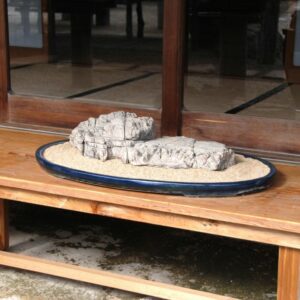
Suiseki stone
Suiseki is the art of appreciating an individual stone, which reminds the viewer of the beauty of natural scenery.
There are a few characteristics that stones should have to be called a Suiseki.
Number of stones
Suiseki aims to admire and appreciate one single stone. Bonseki, on the other hand, appreciates the beauty of stones in the same way as Suiseki but uses several stones and sand on a tray to design landscape.
Size of stones
There is no set size for the Suiseki, but the stone should be small enough for one person to carry around and display since Suiseki is meant to be viewed indoors. A rock as large as that in a Zen garden cannot be called a Suiseki. Tiny stones that make it difficult to represent natural scenery are not suitable as well.
Unprocessed and untouched
Suiseki should be as unprocessed as possible because Suiseki is a way of appreciating the natural beauty of stones as they are.
So, stones cannot be attached to other stones, carved or colored to make them look better. Suiseki does not seek the beauty of precious stones, extracted by selecting the most valuable part of the stone by human hands.
Similarly, stones that are artificially covered with moss or planted with trees or grass are not called Suiseki (can be bonsai on the rock).
Shape and value
Suiseki is not just a stone with an interesting shape or of rare value. A stone cannot be called Suiseki unless it evokes the beauty of nature by the viewer.
Classification of Suiseki
Suiseki stones can be classified into various categories based on their shape, texture, or color but these classifications serve as guidelines to help appreciate and understand the diverse range of Suiseki stones.
- Landscape stone
- Object stone
- Patterned stone
- Color stone
Landscape Stones
As the name suggests, landscape stones resemble miniature landscapes, capturing the essence of mountains, cliffs, and waterways. The landscape stones are further divided into the followings:
- Distant mountain stones
- Plateau stones
- Hill stones
- Waterfall stones
- Water pool stones
- Shore stones
- Island stones
Distant mountain stones
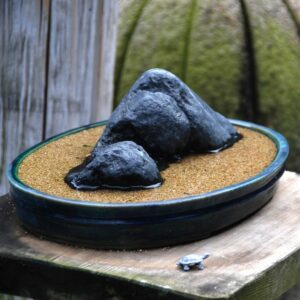
Distant mountain stone (Suiseki)
Distant mountain stones represent mountain ranges as viewed from a great distance.
Plateau stones
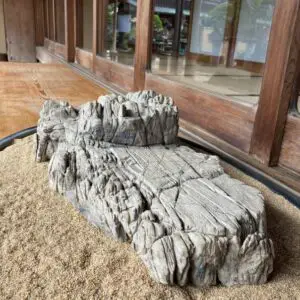
Plateau stone (Suiseki)
Plateau stones represent terraced plateau rising toward a hill.
Hill stones
Hill stones represent hills in the distance in plain fields.
Waterfall stones
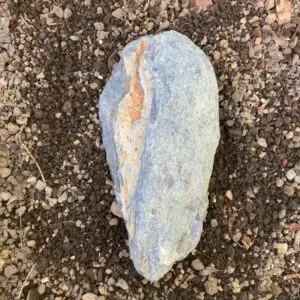
Waterfall stone (Suiseki)
Watersall stones represent one or more white waterfalls.
Water pool stones
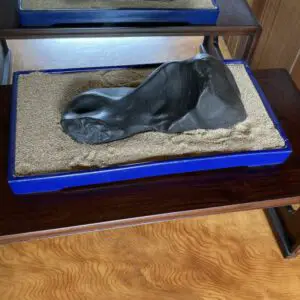
Water pool stone (Suiseki)
Water pool stones represent lakes, ponds or water pools.
Shore stones
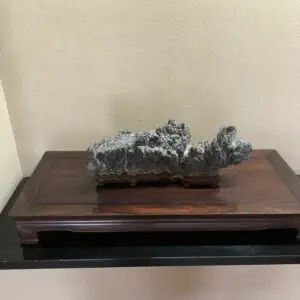
Shore stone (Suiseki)
Shore stones represent rocky shores by the sea.
Island stones
Island stones represent an island rising out of a lake or sea.
Object Stones
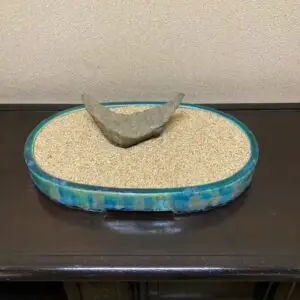
Object stone- boat shape (Suiseki)
Object stones resemble objects or figures, such as animals, human forms, or man-made structures.
Patterned stone
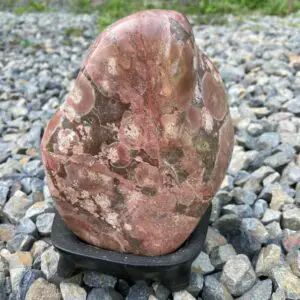
Symbol stone- flower shape (Suiseki)
Patterned stones are those with patterns that can be seen in nature such as flowers, clouds, and butterflies or even characters (alphabets).
Color stone
Color stones are those with beautiful colors- by their deep, subdued, and excellent color.
Understanding Suiseki
Pronunciation
The word “suiseki” is pronounced as “sou-ee-se-ki.” The first and the second syllable, “sou-ee,” is actually NOT a diphone as in the word “sweet,” but a pair of different individual sounds,”sou” and “ee”. The next syllable, “seki,” rhymes with “necky.”
Meaning of Suiseki
The word “Suiseki” is comprised of two Japanese characters: “sui” (水) and “seki” (石) where “sui” means water and “seki” means stone. So, when combined, does the word Suiseki mean water stone? Actually not.
Surprisingly (or not), the word “Suiseki” is very closely related to the Zen garden, “Kare-Sansui”. Originally, Suiseki was called “San-sui-seki” consisting of three characters: “san”, “sui”, and “seki”. “San” means mountain, “sui” means water, and “seki” means stone.
While “sui” literally means water, it actually means a body of water here: river, lake, or sea. As the zen garden, “Kare-Sansui”, “Sansui” means mountain and the body of water, which translates to the landscape or nature. And so, “San-suiseki” or Suiseki means the stones that reminisce the natural landscape.
Over time, the term “Suiseki” emerged as a shortened form of “San-suiseki”, with the first character “san” being dropped. It is uncertain why it happened but maybe because it is simpler and easier to pronounce.
History of Suiseki
Along with Zen Buddhism and other cultures, the art of stone appreciation was originally brought from China before going through a series of changes in Japan to settle in the current form of Suiseki.
Pre-history
The roots of Suiseki trace back to Chinese Penjing, the ancient art that dates back 2000 years, and Chinese Gongshi, the viewing stones.
In the original Chinese Penjing, people aimed to express the beauty of natural scenery in a pot using plants, stones, water, and soil as materials. Gongshi, on the other hand, is the appreciation of viewing stones that was developed by scholars and literati.
Early history
With the influence of Zen philosophy of simplifying and reducing the complex world into an abstract form, the art of Chinese Penjing has gone some transformation in Japan together with Gongshi. Living trees, soil and water are omitted leaving stones/rocks and sand to represent the natural landscape.
Long story short, Penjing developed into the original form of Suiseki in around 14th century Japan as a mixture of today’s Zen garden, Bonseki and Suiseki. Let me explain what they are.
Zen garden is a miniaturized landscape with rocks.

Zen garden
Bonseki is a miniaturized landscape on a plate (“bon”) using white sand and stones (“seki”).
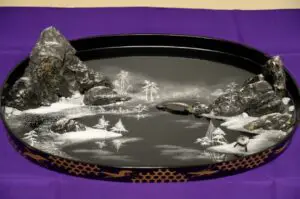
Bonseki
(Source: Higo-Hosokawa Garden)
Suiseki is a stone that represents a miniaturized landscape.

Distant mountain stone (Suiseki)
By looking at these pictures, I think you can see the resemblance between these three art forms. All of them use stones/rocks (and sand for Zen garden and Bonseki) to represent landscape in miniature form, though with a different scale.
Combined with the nature worship of rocks as sacred objects, the concept of appreciation of stones that were brought from China has evolved in its own way in Japan.
Evolution
During the Edo Shogunate period in the 17th, 18th and early 19th centuries, Zen garden, Bonseki and Suiseki established themselves as a distinctive art form; Zen garden creating a landscape in a garden using rocks, Bonseki creating miniature landscapes using stone on a tray and Suiseki just admiring a stone as it is.
Bonsai and Suiseki
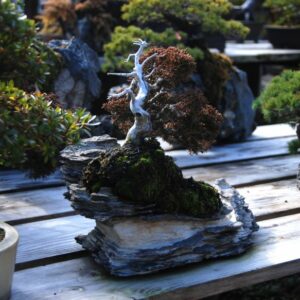
As mentioned earlier, the practice of cultivating miniature trees (bonsai) and appreciating natural stones (Suiseki) has roots in ancient Chinese culture. Chinese scholars developed the art of Penjing, which involved creating miniature landscapes with trees, rocks, and other elements. The appreciation of viewing stones, known as Gongshi, also flourished in China.
Penjing and Gongshi were brought to Japan by Buddhist monks and imperial missionaries who traveled from Japan to China from the 7th to 9th centuries.
The original form of Penjin used plants, stones, water, and soil as elements to recreate the landscape in miniature. Over time, trees, soil and water were omitted leaving stones to develop into Suiseki, and the part that was “omitted”, trees and soil, has transformed into bonsai.
As such, they share the same aesthetic principles, “wabi” and “sabi”, an appreciation of the simple yet imperfect beauty of nature in a miniature form. Trees and stones are symbolic references to allow viewers to make metaphorical associations with nature.
In bonsai, viewers see an illusion of a larger landscape within the confined space of a bonsai pot. The tree’s branches, foliage, and overall form are manipulated to suggest the look of a full-grown, aged tree growing in a specific environment, such as a tree clinging to a rocky cliff.
When appreciating a Suiseki stone, viewers use their imagination to see beyond the physical form of the stone itself. They look for resemblances, patterns, or qualities that evoke a sense of a larger landscape. It allows viewers to mentally project landscapes, objects or other symbolic representations onto the stone.
If you are interested in “Wabi and Sabi” and the Zen influence on bonsai, please check the following post.
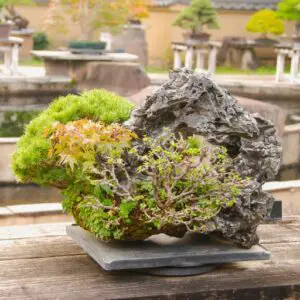
Japanese maple- bonsai on rock
The combination (of a kind) of both bonsai and Suiseki is bonsai-on-rock style. In this style, the bonsai tree is planted directly on or alongside a carefully selected stone that looks like a mountain, cliff or island, both of which can be a stand-alone piece of bonsai or Suiseki.
Judging Suiseki

Shore stone (Suiseki)
Key factors in judging Suiseki
When evaluating Suiseki stones, the following 5 key factors come into play:
- Shape
- Quality
- Color
- Texture
- Patina
Shape
The shape of a Suiseki stone is of utmost importance. It should have an intriguing form that reminisces nature. Balance and proportion are also important, especially the three sides of the stone that are well harmonized.
These three sides are the front and back, left and right, and the bottom of the stone. So, the stones that are balanced in front and back, right and left and the bottom with harmonious size, shape, and thickness on all three sides are desirable.
Quality
Suiseki stones require durability that is resistant to chipping or deterioration. An ideal Suiseki stone has properties that remain more or less unchanged over time, maintaining its color and integrity even when exposed to sunlight, wind, or rain.
That said, it doesn’t necessarily have to be as hard as a gemstone. A high-quality Suiseki stone would exhibit a moist appearance when watered, giving it a sense of vitality and moisture.
Color
The ideal colors for Suiseki stones are clear, dark, subdues, and deep. Shades like black, blue-black, grey-black, and dark brown, which align with the aesthetic principles of Wabi-Sabi, are considered desirable.
Vibrant colors and murky hues should be avoided, and transparent shades like gemstones are not preferred.
Texture
Texture refers to the surface quality of the stone. No particular texture is preferred and Suiseki stones may have smooth, rough, or weathered surfaces but the texture should be intriguing to watch.
Patina
Patina refers to the development of a natural sheen or luster on the surface of a Suiseki stone over time. A well-developed patina indicates age and weathering, which should be developed and enhanced by exposing a stone to the sun and watered from time to time, just like a bonsai tree. This process is called a “cultivation” of a stone.
Displaying Suiseki
There are 2 methods in the traditional way of appreciating Suiseki: using (1) a water basin and (2) a pedestal.
Water basin

Object stone- boat shape (Suiseki)
When using a water basin, sand is placed inside the basin and the stones are positioned on top of it. The basin itself resembles a tray, with a rim that is lower than that of a bonsai pot.
When viewing Suiseki in a water basin, it’s crucial to select the shape, size, and color of a basin that matches the stone.
Shape
There are various types of water basins available, such as rectangular, oval, or glazed/unglazed. It is important to find a basin that harmonizes with the characteristics of the stone.
Size
A general guideline for the size of the water basin is a proportion of approximately 3 for water basins to 2 for a Suiseki stone.
Color
While there is no strict rule for the color combination between the Suiseki and the water basin, it’s preferable for the basin to have a tranquil and pale color that complements the stone.
Sand
Ordinary sand is OK for filling the basin, but very white or dark sand is not recommended for Suiseki. The sand grains should be fine and of similar size to create a harmonious and balanced visual effect.
Pedestal

Suiseki on a pedestal
While Suiseki can be appreciated using a basin or a pedestal, some stones must be displayed on a pedestal when the bottom of the stone is not flat or there are specific features that cannot be seen when placed in a basin.
Since each stone is unique, you need to either create the pedestal for the stone yourself or look for someone who can make it for you.
The pedestal should be designed in a way that enhances the beauty of the stone. Typically, wood is chosen as the material for the pedestal, with hardwoods like cherry or zelkova being preferred due to their durability and weight.



